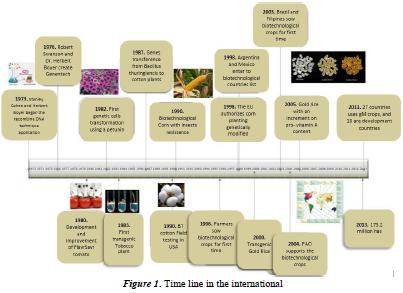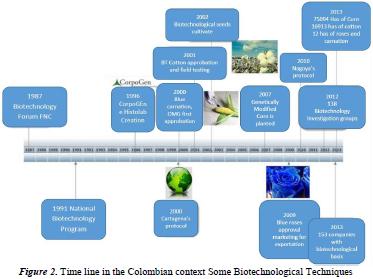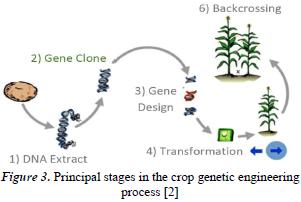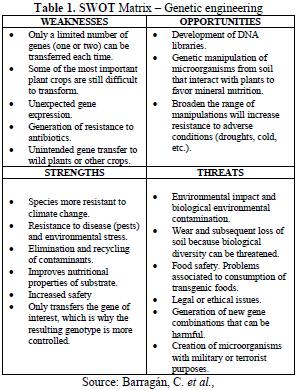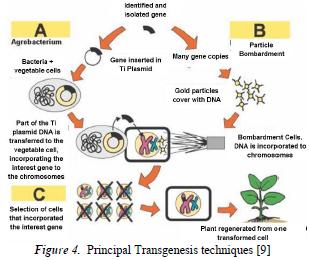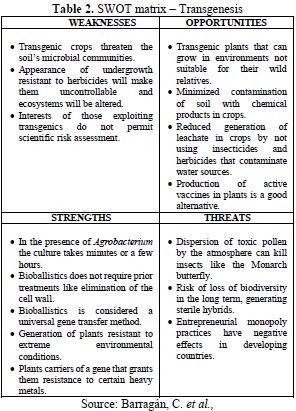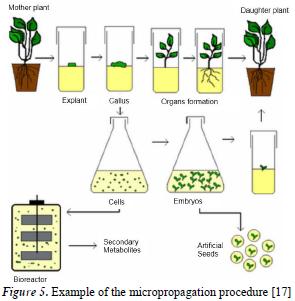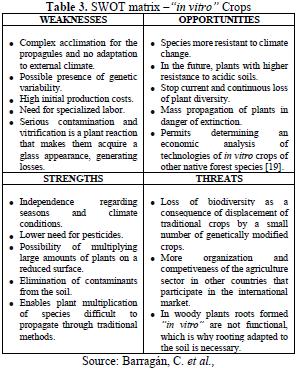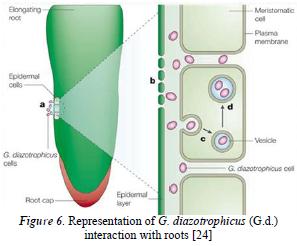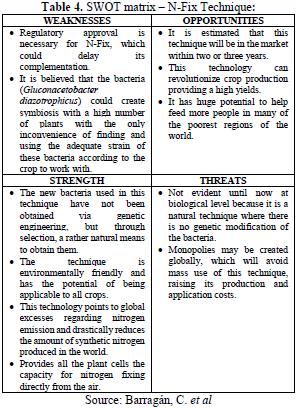Serviços Personalizados
Journal
Artigo
Indicadores
-
 Citado por SciELO
Citado por SciELO -
 Acessos
Acessos
Links relacionados
-
 Citado por Google
Citado por Google -
 Similares em
SciELO
Similares em
SciELO -
 Similares em Google
Similares em Google
Compartilhar
Tecciencia
versão impressa ISSN 1909-3667
Tecciencia vol.9 no.16 Bogotá jan./jun. 2014
https://doi.org/10.18180/tecciencia.2014.16.2
DOI: http://dx.doi.org/10.18180/tecciencia.2014.16.2.
Discussion on the implications upon the environment of some technologies from the second green revolution
Discusión sobre las implicaciones en el ambiente de algunas tecnologías de la segunda revolución verde
Grace Andrea Montoya Rojas1*, Claudia B Barragan2, Miguel Herrera Aranguren3, Neils A. Martínez Hernández4, Rosa I., Rodríguez Tolosa5, Rosa Shirley Villamil Gil6
1 Universidad Jorge Tadeo Lozano, Bogotá, Colombia, gmontoya@ecci.edu.co.
2 Universidad Jorge Tadeo Lozano, Bogotá, Colombia, claudia.barragan@utadeo.edu.co.
3 Universidad Jorge Tadeo Lozano, Bogotá, Colombia, miguel.herrera@utadeo.edu.co.
4 Universidad Jorge Tadeo Lozano, Bogotá, Colombia, antonio.martinezh@utadeo.edu.co.
5 Universidad Jorge Tadeo Lozano, Bogotá, Colombia, rosai.rodriguez@utadeo.edu.co.
6 Universidad Jorge Tadeo Lozano, Bogotá, Colombia, Shirley.villamaring@utadeo.edu.co.
How to cite: Montoya Rojas, G., et al., Discussion on the implications upon the environment of some technologies from the second green revolution, TECCIENCIA, Vol. 9 No. 16., 22-32, 2014 DOI: http://dx.doi.org/10.18180/tecciencia.2014.16.2
Received: 09 Apr 2014 Accepted: 28 May 2014 Published: 30 Jul2014
Abstract
The Second Green Revolution explores genetic progress based on the application of modern biotechnology to agriculture, seeking to improve agricultural practices and products. Likewise, its main aspect is the creation of genetically modified organisms (GMO), best known as transgenics. The Second Green Revolution implies using techniques like micro-propagation, genetic engineering, and - more recently - using bacteria as potential bio-fertilizer, among them nitrogen-fixing, phosphate-solubilizing, and auxin producer bacteria, etc. Genetic engineering groups techniques of gene identification, selection, transference, and control, with transgenesis being the genetic engineering technique most applied in agriculture. With the tools, techniques, and methodologies of modern biotechnology, it is possible to more quickly produce new plant varieties than before, with improved nutritional characteristics, tolerance to adverse conditions, resistance to specific herbicides, and pest control. Soil integrates environmental components and permits development of life, life which in turn forms soils offering broadly diverse ecosystemic opportunities, constantly nourishing and producing food for all species, including man. However, the alteration of the soil-forming factors, due to natural cycles or man's intervention, impacts notably on its productivity and the temporality demanded by humans. Between supply and demand an increasingly broadening gap is forged and the dehumanization of territories when trying to schematize nature, offers opportunities to science to meet needs with different techniques.
Keywords: Agriculture, biotechnology, genetic engineering, micro-propagation, edaphology, agro-ecology, environment.
Resumen
La segunda revolución verde explora el avance genético basado en la aplicación de la biotecnología moderna a la agricultura buscando mejorar prácticas y productos agrícolas. Igualmente, tiene como principal aspecto la creación de organismos genéticamente modificados (OGM) mejor conocidos como transgénicos. La segunda revolución verde implica el uso de técnicas como la micropropagación, la ingeniería genética y más recientemente el uso de bacteria con potencial biofertilizante entre ellas las fijadoras de nitrógeno, solubilizadoras de fosfatos, productora de auxinas, etc. La ingeniería genética agrupa técnicas de identificación, selección, transferencia y control de genes, siendo la transgénesis la técnica de ingeniería genética más aplicada a la agricultura. Con las herramientas, técnicas y metodologías de la biotecnología moderna es posible producir nuevas variedades de plantas con mayor rapidez que antes, con características nutricionales mejoradas, tolerancia a condiciones adversas, resistencias a herbicidas específicos y control de plagas. El suelo integra los componentes ambientales y permite el desarrollo de la vida, vida que a su vez forma suelos ofreciendo oportunidades ecosistémicas de muy amplia diversidad, nutriéndose constantemente y produciendo alimento para todas las especies, incluyendo el hombre. Sin embargo, la alteración de los factores formadores del suelo, ya sea por ciclos naturales o la intervención del hombre, inciden notablemente en su productividad y la temporalidad que el humano demanda. Entre la oferta y la demanda, se forja una brecha cada vez más amplia y la deshumanización de los territorios al tratar de esquematizar la naturaleza, da oportunidades a la ciencia para suplir las necesidades con diferentes técnicas.
Palabras clave: Agricultura, biotecnología, ingeniería genética, micropropagación, edafología, agroecología, medio ambiente.
1. Introduction
Conventional agriculture, based on chemistry, mechanics, and genetics began consolidating by early 20th century from a series of scientific discoveries like chemical fertilizers, selection of high-production plants, and development of combustion engines. Till then, the fertility of soils was maintained through crop rotation and animal and plant production were integrated. The massive introduction of chemical fertilizers and, later, of agrotoxins1, the use of high-yield hybrids, and mechanization of agriculture, permitted intensifying production systems, abandoning rotation systems, and move on to monoculture and, thus, separate animal and plant production [1]
The second green revolution began in 1973 with the appearance of the first genetically modified petunia. In 1976, the first biotechnology company (Gentech) was created; since then progress has been produced in different plant species. In 1996, progress led to the plantation of biotechnological crops for the first time and in 2004 the Food and Agriculture Organization supported the use of these types of crops. Figure 1 integrates the time line of the international context of the technological progress of the second green revolution.
Within the Colombian context, in 1987 the first forum was held on biotechnology applied to tropical crops organized by the National Coffee Federation; later, in 1991, the national biotechnology program was approved and, in 1996, the first two Colombian biotechnology companies appeared (Histolab and CorpoGen). Colombia began its participation in commercial planting of biotechnological crops in 2002, with planting of blue carnations for export. The controlled planting scheme, GM corn planting began in 2007, and toward 2009 planting of blue GM roses was approved [1]. Currently, Colombia has over 100,000 h of these crops; mainly corn, cotton, carnations, and roses. Figure 2
Illustrates a time line of the national and international context of the different technologies and their progress. Transference of the transgenic model confronts environmental conditions in our country, which are essentially different from those predominating in countries where the Green Revolution originated. Colombia's climate is dominated by periods of higher or lower precipitation, with constant temperatures throughout the year (but with strong daily variations), regulated by altitudinal tiers; its soils are highly diversified and most are in slope positions with pronounced inclinations, making it necessary to review the effects that can be caused by biotechnological techniques on ecosystems and society. This work seeks to briefly show an analysis of the edaphological implications with biotechnological techniques of: genetic engineering and transgenesis, micropropagation, and nitrogen-fixing bacteria applied during the second green revolution; reviewing the cost-benefit ratio of these new techniques, their weaknesses, opportunities, strengths, and threats on the atmospheric, geosp.
2. During the Second Green Revolution
To understand the incidence of the technologies of the second green revolution upon environmental components, knowledge should first be led toward initial awareness of some of those technologies in a simple manner. Thereafter, a discussion is made on the environmental implications of the technique within a SWOT matrix. 2.1 Genetic engineering Genetic engineering is a biotechnology application in which DNA of a given organism is manipulated, incorporating onto it genes from other species so it manifests more convenient genetic traits according to the objective sought..
Genetic engineering can be carried out for agricultural purposes and can also be used to transfer genes that make plants produce valuable substances for the pharmaceutical or chemistry industries. Transgenic plants become living factories as bio-reactors of high value added substances; here, large investments or specialized workers are not needed. For a transgenic plant to reach the market it must go through a series of phases, which go from the first laboratory tests, to greenhouse tests and small field tests, and - finally - to commercial crops. The last phases are regulated by ad hoc legislations in different countries. The first "transgenic foods" have been reaching stores in some countries since 1994 (as is the case of "Flavr Savr" tomatoes that ripen more slowly than the "conventional" tomatoes). The genetic engineering process in plants has five principal stages (Figure 3): a). DNA is extracted from an organism that presents a characteristic of interest; b). The particular gene that encodes the desired protein is located and the total DNA extracted from the organism is copied; c). The gene is modified for it to be expressed specifically when it is inside the plant; d). The new gene is inserted in individual cells by using methods like bioballistics or Agrobacterium; d). Backcrossing is used to transfer the transformed gene to an elite high-performance line; the resulting hybrids are tested and evaluated for their release. The final result is a transgenic hybrid or high-yield variety that expresses a new characteristic.
2.1.1. Analysis of Genetic Engineering in the Environment
Plant genetic engineering currently faces some limitations: only a limited number of genes (one or two) can be transferred each time; some of the most important crop plants are even more difficult to transform; the foreign gene is randomly integrated (and not in sites predetermined by the researcher); genes inserted are not generally expressed at the same level or can have a limited expression; some transgenes can end up being inactivated and losing their function. According to some investigations by Kwiatkowsk et al., Benitez, Peacock, and recent progress [3] [4] [5], Table 1 compiles through a SWOT matrix an analysis of the technique and the environmental component it affects most.
Genetic engineering permits modifying or adding a new characteristic to a known variety, adapted and accepted by farmers and consumers, seeking to correct a problem of the variety to treat like lack of resistance to a pest or disease, or lack of tolerance to drastic climate changes or to environmental stress (frost, drought, radiation, cold, salinity, height). Planting the natural variety is no longer profitable because it does not produce enough, or the harvest has low quality, which is why its demand has diminished, or requires excessive application of pesticides. This is quite costly and contaminates soils, waters, and living beings; leading to experimenting with bacteria genes like Bacillus thuringiensis for these to develop insecticide proteins and, thus, reduce the use of pesticides. According to Brooks [6], from 1995 - 2011, this technology has been beneficial with the reduction of 443-million tons of pesticides, reduction of 19-million kilograms of C02 released onto the environment (equivalent to removing 9-million automobiles from the roads for one year) and increased agricultural income of US$78-billion.
Technologies to produce GMOs and many of the useful genes have been developed and patented in industrialized countries, which is why there is concern that these technologies and genes will not be at the reach of farmers in the developing world. We must bear in mind that this technology is still in its early stages and some of the problems cited will be solved in a few years. In the future, it is expected to broaden the range of manipulations, including complex processes influenced by several genes: resistance to adverse conditions (droughts, cold, etc.); improved yield by manipulating the response to light; genetic manipulation of microorganisms of the soil that interact with plants to favor mineral nutrition, improve defense mechanisms against fungi, bacteria, and pathogenic nematodes, and perhaps achieve new nitrogen-fixing species (which would diminish current dependence on chemical fertilizers). In the field of floriculture, new varieties of ornamental plants are observed with new colors, aromas, and floral designs, surprising plant shapes, etc. According to Desmond Nicholl (2002) [7], "the concern on these technologies emerges with the possibility derived from gene manipulation by scientists who individually and without needing very powerful and sophisticated equipment can develop in their laboratories almost any type of research and upon which - in principle - no control mechanism exists", which leads to thinking that the solution to food safety is not as evident with this technique; on the contrary, it brings uncertainty to human health and to the health of the ecosystem and will probably demand opportunities to investigate their own research products.
2.2. Transgenesis Transgenics are organisms to which one or more genes from another species have been introduced. Transgenic plants have genes of all origins: from other plants, from animals, from bacteria, from viruses, and from fungi, and often have combinations of these, given that they are needed to put together complex molecular systems to guarantee the expression of foreign genes. Transgenesis induced by infection with Agrobacterium tumefaciens or Agrobacterium rhizogenes and bombardment of cells with micro-projectiles covered with DNA are the principal techniques with which it has been possible to obtain transgenic plants from different plant species. The most common method to transfer exogenous genes to plants is based on transformation vectors derived from Agrobacterium tumefaciens and Agrobacterium rhizogenes, two bacteria that are normally found in soil and which contaminate the cells of many dicotyledonous plants. Upon contaminating the plant cells, the first of these bacteria provokes a tumoral formation that is noted as a crown gall, while the second forms provisional roots in the contaminated zone. Regarding Agrobacterium tumefaciens, said formations are the consequence of the transference, by the bacteria, of a DNA segment called T-DNA that is part of an important plasmid (called Ti: tumor inducing) present in the bacterial cell in the plant's nuclear DNA. [8] The other method of great importance in transgenesis is bioballistics (bombardment of cells with micro-projectiles), which occurred because the Agrobacterium tumefaciens bacteria was unable to function in monocotyledonous species, which constitute an important group of cereals. The technique is based on the acceleration of micro-projectiles (0.4 to 4 micra) covered with DNA that impact cell or plant tissue with sufficient force to go through the cell wall and membrane. Once inside the cell, the DNA is dissociated from its support and integrates to the cell's DNA. The micro-projectiles can be accelerated in several manners; mainly, compressed air or helium is used. The micro-projectiles penetrate the cells circulating the genetic material adhered to them without irreversibly compromising the integrity of the cells, given that the lesions produced are temporary. The targets used in this technique are cell suspensions, callus, immature embryos, meristems, pieces of leaves, microspores, and pollen [8]. Figure 4 summarizes the two principal techniques of transgenesis.
2.2.1. Discussion of Transgenesis in the Environment According to Chavarri et al., grasses and, in general, all monocotyledonous present great resistance to Agrobacterium, which is why this method is highly unviable in a vast group of plants of economic importance. Bioballistics is considered a universal gene transference method and given that because it is a physical method it is not linked to any biological condition and can be used with different types of organisms. [10] A problem posed by this technique (bioballistics) is that two types of cells are generated: transformed and nontransformed within the same organ. According to Martínez (2005), competition appears between the two cell types, diminishing the effectiveness of the method [11]. Adding new characteristics to plants can represent - in some cases - breaking natural associations with other forms of life (for example, pollinators), and because of this changing or breaking normal cycles of ecological functioning, affecting the whole ecosystem. The possibility exists that genetically modified plants (GMP), due to the effect of the new genetic material introduced, may modify their ecological habits, dispersing over and invading ecosystems, as bad weed. For Chaparro and for Mendoza (2005), among the benefits found is that of obtaining new plant varieties with tolerance to drought and salinity [12], and modification of physical or organoleptic characteristics to increase the nutritional value of plat-origin foods. [13] Both, the problem of genetic contamination and the problem of extinction of wild species are irreversible and their environmental consequences are disastrous, given that these wild forms are the reservoirs of variability offered by nature, and without them plant forms would increasingly homogenize and not be able to face changes that require adaptations. All forms, including transgenic forms, will end up extinguishing; likewise, new products of transgenic plants can have adverse effects when introduced into trophic chains; it has been noted that certain substances of viral origin can damage the immune system of mammals and that many of the substances generated in transgenic plants are carcinogenic.
2.3. Micropropagation -"in vitro" CropsMicropropagation, according to Delgado and Villalobos, is a plant propagation method that permits large-scale production of mother plants free of pathogenic agents, including virus; this method is being mainly applied in plantains, bananas, citric plants, pineapples, ornamental plants, flowers, and some perennial or forest species of commercial interest like eucalyptus, oil palm, rubber, among others [14] [15].
The in vitro culture of plant tissue is a reproduction technique under totally aseptic conditions in which from a small initial segment of tissue it is possible to quickly regenerate thousands or millions of plants genetically the same as the mother plant [15], when this tissue is stimulated through controlled physical and chemical variables in a culture medium. For the practical development of in vitro plant cell cultures, five stages are established, thus: selection of the explant, establishment of the culture medium, tissue development, rooting and conditioning, and - lastly - adaptation of seedlings [15]. Each of the stages will be critical according to the objectives proposed [16]. Figure 5 shows a procedure example for micropropagation.
According to the needs or objectives of the application of cultures of plant tissues, some specific techniques are distinguished that are developed in laboratories. A classification [15] of these can be given in the following manner:
- Clonal propagation (micropropagation)
- Meristem culture
- Germplasm conservation
- Production of haploid plants
- Embryo rescue
- Somaclonal variation ("in vitro" selection)
- Mutagenesis h. Somatic Hybridization
2.3.1. Discussion of Micropropagation - "in vitro" Crops in the Environment
Micropropagation is a good option to generate plants more resistant to pathogens, virus, and bacteria and although it is a very good strategy to multiply and propagate plants in shorter time, with good physical characteristics, and even nutritional and more resistant, besides the option of obtaining the specie desired at any time of the year. It is a difficult method to reach, given that starting micropropagation processes requires specialized laboratories - making it a very costly method [18]. Additionally, the place must be totally aseptic using chemicals that may have high costs. Table 3 shows strengths, weaknesses, opportunities, and threats regarding the use of the in vitro crop micropropagation method.
Through this technique, we can obtain plants genetically identical to the original sample and in large numbers. This becomes quite useful in obtaining plants free of pathogens, homozygous plants, in the production of plants in danger of extinction, in genetic engineering studies, etc. It also permits substantial savings of time with respect to conventional propagation techniques. According to Remache (2011) [19], juvenile explants like zygotic embryos, cotyledons, hypocotyls, or seedling yolks and juvenile leaves have higher response to in-vitro crop than other tissues of adult trees. Given that meristematic tissues exist there, they help the plant to grow more rapidly; for this reason in most cases juvenile explants are taken, besides guaranteeing their being healthier without leaving aside that these also require specialized laboratories with good aseptic standards. Among the potential ecologic risks identified is increased undergrowth due to cross-pollination where pollen from GM crops (genetically modified crops) is spread to non-GM crops in nearby fields. This can cause the dispersal of certain characteristics like resistance to herbicides from GM plants to those that are not GM, with the subsequent potential of becoming undergrowth [20].
2.4. Nitrogen Fixing without Nitrogen Fertilizers Nitrogen fixing and the process through which nitrogen becomes ammonia are vital for plants to grow and survive. However, only a small number of plants, like legumes (peas, beans, and lentils) have the capacity to fix nitrogen from the atmosphere with the aid of fixing bacteria. These bacteria are very important components of soils [21]. Several biological nitrogen fixation systems have already been described in prokaryotic organisms. Among the nitrogen-fixing organisms (or diazotrophic), many are heterotrophic, which need a reduced carbon supplement and others depend indirectly on light energy. In general, these require symbiosis with a eukaryotic host or can be free living, competing with other microorganisms for the organic matter available in the environment. Representative species have been described from various nitrogen-fixing prokaryotic groups, such as: photosynthetic bacteria (Rhodospirillum rubrum), anaerobic bacteria (Clostridium spp.), micro-aerobic bacteria (Azospirillum spp., Herbaspirillum spp., Gluconacetobacter diazotrophicus, Azorhizobium caulinodans, Azoarcus spp., Burkholderia spp., Klebsiella spp., among others), aerobic bacteria (Azotobacter spp., Derxia spp. Beijerinckia spp.) and some species of cyanobacterium (blue-green algae) and actinomycetes (Frankia sp.) [22]. To increase soil fertility, N-fixing bacteria produce enzymes that, under adequate environmental conditions, take gaseous nitrogen from the atmosphere and fix it to bacterial biomass. If the bacteria satisfy their nitrogen needs, then it is released to the plant and the high levels of proteins constructed from this nitrogen are observed in the plant itself [21]. A new nitrogen-fixing technology has been developed, which will help to transform agriculture. This technology permits all crops to take nitrogen from the atmosphere instead of doing it from fertilizers based on very costly nitrogen and which is potentially harmful to the environment [23]. This novel technology, known as N-Fix permits plants to naturally obtain the nitrogen they need and eliminate their dependency on synthetic nitrogen fertilizers (Figure 6).
A strain of Gluconacetobacter diazotrophicus endophytic bacteria, specifically G. diazotrophicus IMI 501986 was discovered, which can fix nitrogen and can create symbiosis with other plants that are not legumes. It was accomplished for this strain to have symbiosis with sugarcane (Saccharum officinarum) in a totally natural process, without the need for any genetic modification. This technique seeks to suspend the sugarcane seeds in a liquid containing the bacteria, given that these are endophytic they are introduced without any type of stimulation in the seed cells and are developed at the same time as the plant, extending throughout all its cells giving each the capacity of naturally fixing atmospheric nitrogen.
2.4.1. Discussion of N-Fixing in the Environment Gluconacetobacter diazotrophicus is a diazotrophic bacteria that has been found to colonize, in large numbers, the internal tissues of plants, like sugarcane, sweet potato (Ipomoea batatas), pineapple (Ananas comosus), and rice (Oryza sativa). Additionally, from the capacity for N2 fixing in association with sugarcane plants, it has been demonstrated that this bacteria has other interesting physiological capacities like production of phytohormones, solubilization of phosphates and zinc, as well as control of phytopathogens [25]. Due to the aforementioned, it can be noted how important this type of bacteria is for the development of the N-Fix technique, which is environmentally friendly (clean technology), does not contain toxins, and is a "Non-GM" technology (non-genetically modified). An aspect that is attracting attention lately is if the use of pesticides for pest control can affect the presence in the soil and the capacities the N-Fix has, especially Gluconacetobacter diazotrophicus. In this regard, some studies have been done seeking to identify the pesticides used in the sugarcane crop that do not affect growth or damage the biological nitrogen fixation (BNF) capacity of diazotrophic bacteria like G. diazotrophicus. In this study, five insecticides were tested in their respective dosages with respect to the commercial impact on the growth of these bacteria. None of the insecticides tested affected significantly the growth support capacity of G. diazotrophicus and none of the insecticides caused adverse effects on the nitrogen fixing capacity in in-vitro crop [26]. This could be a limitation in the sense that pesticides used for pest control in some crops are not always safe for the N-Fix.
Synthetic fertilizers containing the necessary nitrogen for correct plant development represent an environmental risk associated to contamination of underground water sources through leachate processes. N-Fix constitutes a technique with great benefits regarding the use of nitrogen fertilizers, offering alternatives of using clean technologies that guarantee adequate food safety; while in the current market of nitrogen-fixing bacteria (for example rhizobia) is limited to a few crops of legumes, the market for bacteria that fix nitrogen internally in plant cells (N-Fix) offer access to all crop species in the world, drastically reducing the amount of synthetic nitrogen produced in the planet.
Field results based on chlorophyll measurements on leaves and total content of foliar nitrogen; the findings obtained in the laboratory confirm the high crop yield of N-FIX, which permits their use to substitute significant amounts of nitrogen fertilizers [23]. Benefits are potentially massive, given that it generates lower dependence on nitrogen fertilizers, substituting nearly 60% of the plant's nitrogen need. It has been shown that inoculating seeds with N-Fix before planting leads to successful colonization of nitrogen-fixing bacteria in each of the crops treated [23].
3. Conclusions
Acceptance of biotechnology for food production, above all from the ethical point of view, rests on guaranteeing a series of requisites and protecting widely shared values: that its production be exempt from environmental risks; that foods be safe and nutritional, at reasonable prices; that it contributes to diminish economic inequalities and promote ecologically correct agricultural practices, and ensure sustainability of the planet's live resources. Evaluating the safety of genetic engineering in plants is still uncertain, given that scientists control the primary effects (or what is sought), but cannot control the secondary effects (mediated by natural recombination and mutation processes), which give way to unwanted and unpredictable results. Colombia's biodiversity wealth makes it one of the countries with huge potential for biotechnological development; however, its commercial exploitation must start with the conservation of our ecosystems, where, likewise, biotechnology can be quite useful. If we opt to implement micropropagation in improving plants and crops, we must bear in mind the country's sustainable development and generate entrepreneurial formation in individuals inclined to researching agricultural biotechnology, given that it is where Enterprise can be created based on biotechnology and not merely take it as a process to be applied within scientific progress. From the application of nitrogen-fixing bacteria, agriculture at the global level will be able to change significantly and the N-Fix bacteria can make a real and positive contribution to this change. Additionally, techniques like this one show a clear need to develop new innovative technologies to manage nitrogen contamination according to 21st century needs in the field of agriculture.
The context of the "Second Green Revolution" is not complete without considering the concept of integrated exploitation, that is, without adding at least one link, that formed by animals. On the one hand, over one third of the world's production of transgenic cereals is destined to animal feed, which means an important competitor in the debate on hunger in the world, a high consumption of resources, strong impact of these types of exploitations on the environment, and a new focus on the release of transgenics that is not controlled. Also, genetically modified animals destined for scientific research are a reality. The problem with the script could be more complicated than it is currently. We would have to add increased health costs, treatment of patients from other cultures, identity problems, or the statute of possible more or less human new species [27].
Acknowledgments
The authors thank Grace Andrea Montoya Ro jas, Agrologist Sp, MSc, and PhD in Natural and Human Environment from the Department of Geography at Universidad de Salamanca, Spain, who guided us and motivated us to elaborate this article, for her exercise as graduate professor at Universidad Jorge Tadeo Lozano and research professor at Escuela Colombiana de Carreras Industriales.
The authors also thank Universidad de Bogotá Jorge Tadeo Lozano, Faculty of Natural Sciences and Engineering, Graduate Program, Masters in Environmental Sciences, Edaphology for preparing us and contributing to our professional formation.
Notes
1 "As their name indicates, pesticides are designed to destroy certain live organisms, often being non-selective in complying their function, being able to cause unwanted effects on other living beings, including humans. They can contaminate AIR, WATER, FOOD, SOIL. Some are persistent and can remain for long periods in the environment before breaking down, accumulating in the tissue of most living organisms, when these breathe, ingest foods, or drink liquids. Some do not decompose through natural detox mechanisms. They do not always remain where they were applied. Some can rapidly travel long distances dragged by winds and water, even to remote zones of the planet." http://www.grr.org.ar/campanapdf/guia-basica-agrotoxicos.pdf, retrieved on May 2014.
References
[1] A. Gómez Perazzoli, «AGRICULTURA ORGÁNICA: UNA ALTERNATIVA POSIBLE,» Documentos CEUTA, CEUTA, 2000. [ Links ]
[2] C. Jame, «Brief 42 Global Status of Commercialized Biotech/GM Crops:2010,» ISAAA Brief, 2010. [ Links ] [ Links ]
[4] A. Benitez Burraco, Avances recientes en biotecnología vegetal e ingeniería genética de plantas, Madrid: Reverté, 2005. [ Links ]
[5] K. Wilson Peacock y H. Charles, Biotechnology and Genetic Engineering (Global Issues), Sonlight Christian, 2010. [ Links ]
[6] J. Brooks, M. Filipski, E. Jonasson y E. Taylor, «Modelling the Distributional Implications of Agricultural Policies in Developing Countries,» OECD Food, Agriculture and fisheriees papers, nº 50, 2011. [ Links ]
[7] N. Desmond S. T., An Introduction to Genetic Engineering, Cambridge, 2008. [ Links ]
[8] G. Ancora, E. Benvenuto, G. Bertoni, P. Masan, F. Lucchini, A. Lauria, B. Honings, A. Pessina y V. Buonomo, BIOTECNOLOGIAS,M animales y vegetales. Nuevas fronteras y nuevas responsabilidades, Mexico: Trillas, 2004. [ Links ]
[9] «A Basic Primer on Biotechnology,» North Dakota state University, [En línea]. Available: http://www.argenbio.org/adc/uploads/imagenes_doc/planta_stransgenicas/transformacion.bmp. [ Links ]
[10] M. Chavarri, A. Vegas, A. Y. Zambrano y J. R. Demey, «Transformación de embriones somáticos de mango por biobalística,» Interciencia, vol. 29, nº 5, pp. 261-266, 2004. [ Links ]
[11] M. Martinez, J. Cabrero y L. E. Herrera, «Las plantas transgénicas: una visión integral,» e-Gnosis, nº 2, p. 0, 2004. [ Links ]
[12] A. Chaparro y et al., Introducción a la ingeniería genética de plantas, Bogotá: Unibiblos, 2005. [ Links ]
[13] E. Medoza de Gyves, Agrobiotecnología: la adaptación de las plantas al medio ambiente, no del ambiente a las plantas, Grupo editorial Iberoamerica, 2005. [ Links ]
[14] C. A. Delgado, «Un modelo pedagógico para la enseñanza de la producción biotecnológica de material vegetal. Trabajo de investigación para optar el título de Magister.,» Universidad Nacional de Colombia, Bogotá, 2012. [ Links ]
[15] V. M. Villalobos A. y T. A. Thorpe, «Capítulo 6. Micropropagación: conceptos, metodología y resultados,» de Cultivo de tejidos en la agricultura. Fundamentos y aplicaciones, Cali, Publicación CIAT, 1993, pp. 127-141. [ Links ]
[16] A. Tirado Perea y M. Perea Dallos, Cultivo de tejidos vegetales in vitro : manual de prácticas de laboratorio, Bogotá: Universidad Nacional de Colombia. Facultad de Biología, 2011. [ Links ]
[17] Biotecnología agraria de la Universidad Abierta y a Distancia (UNAD), «Biotecnología Vegetal,» 25 May 2010. [En línea]. Available: http://biotecnologiaveg201529.blogspot.com/2010_05_01_archive.html. [ Links ]
[18] Colciencias, «PLAN ESTRATÉGICO DE BIOTECNOLOGÍA 1999-2004. Programa Nacional de Biotecnología,» 25 October 1999. [En línea]. Available: ftp://ftp.colciencias.gov.co/web/programas/biotecnologia/planest.pdf. [Último acceso: 24 March 2014] [ Links ].
[19] L. M. Remache Yumi, «Desarrollo de una técnica de micropropagación in vitro de cedro (Cedrela montana) a partir de apices, Hojas y entrenudos,» 2011. [En línea]. Available: http://dspace.espoch.edu.ec/bitstream/123456789/1823/1/33T0098%20REMACHE%20LUZ.pdf. [Último acceso: 23 March 2014] [ Links ].
[20] G. M. Romero Vásquez, «Biotecnología: Generalidades, riesgos y beneficios,» 2008. [En línea]. Available: http://www.uned.es/experto-biotecnologia-alimentos/TrabajosSelecc/GloriaRomero.pdf. [Último acceso: 23 March 2014] [ Links ].
[21] Ecoplexity. Teaching econological complexity, «Presence of Nitrtogen- Fixing Bacteria,» Portland state University, [En línea]. Available: http://ecoplexity.org/node/679. [Último acceso: 25 March 2014] [ Links ].
[22] M. F. Garrido Rubiano, Aislamiento e identificación de bacterias diazotróficas rizosféricas y endófitas asociadas a suelos y pastos del valle y sabana del Cesar en dos épocas climáticas, Bogotá: Universidad Militar Nueva Granada, 2007. [ Links ]
[23] Azotic Technologies, «Azotic Technologies. The future in sustainable nitrogen for agriculture,» Azotic Technologies. LTDA, [En línea]. Available: http://www.azotictechnologies.com/index.php/news-and-insight/latest-news/. [Último acceso: 26 March 2014] [ Links ].
[24] «Green Magz. info,» [En línea]. Available: http://www.greenmagz.info/wp-content/uploads/2013/10/2.png . [Último acceso: 26 March 2014] [ Links ].
[25] C. Meneses, L. F. Rouws, J. L. Simoes-Araujo, M. S. Vida y J. L. Baldani, «Exopolysaccharide production is required for biofilm formation and plant colonization by the nitrogen-fixing endophyte Gluconacetobacter diazotrophicus.,» Molecular Plant- microbe Interactions, vol. 24, nº 12, pp. 1448-1458, 2011. [ Links ]
[26] «Crescimento e fixação biológica de nitrogênio de gluconacetobacter diazotrohphicus na presen de inseticidas utilizados na cultura da cana de açúcar,» Amazonian Journal of agricultural and environmental sciences, vol. 56, nº 1, pp. 12-18, 2013. [ Links ]
[27] A. Burgos, J. Cardenas, K. Lara, A. Sierra y G. Montoya, «Panorama investigativo sobre la segunda revolución verde en el mundo y en Colombia,» Tecciencia, vol. 8, nº 15, pp. 49-64, 2013. [ Links ]













